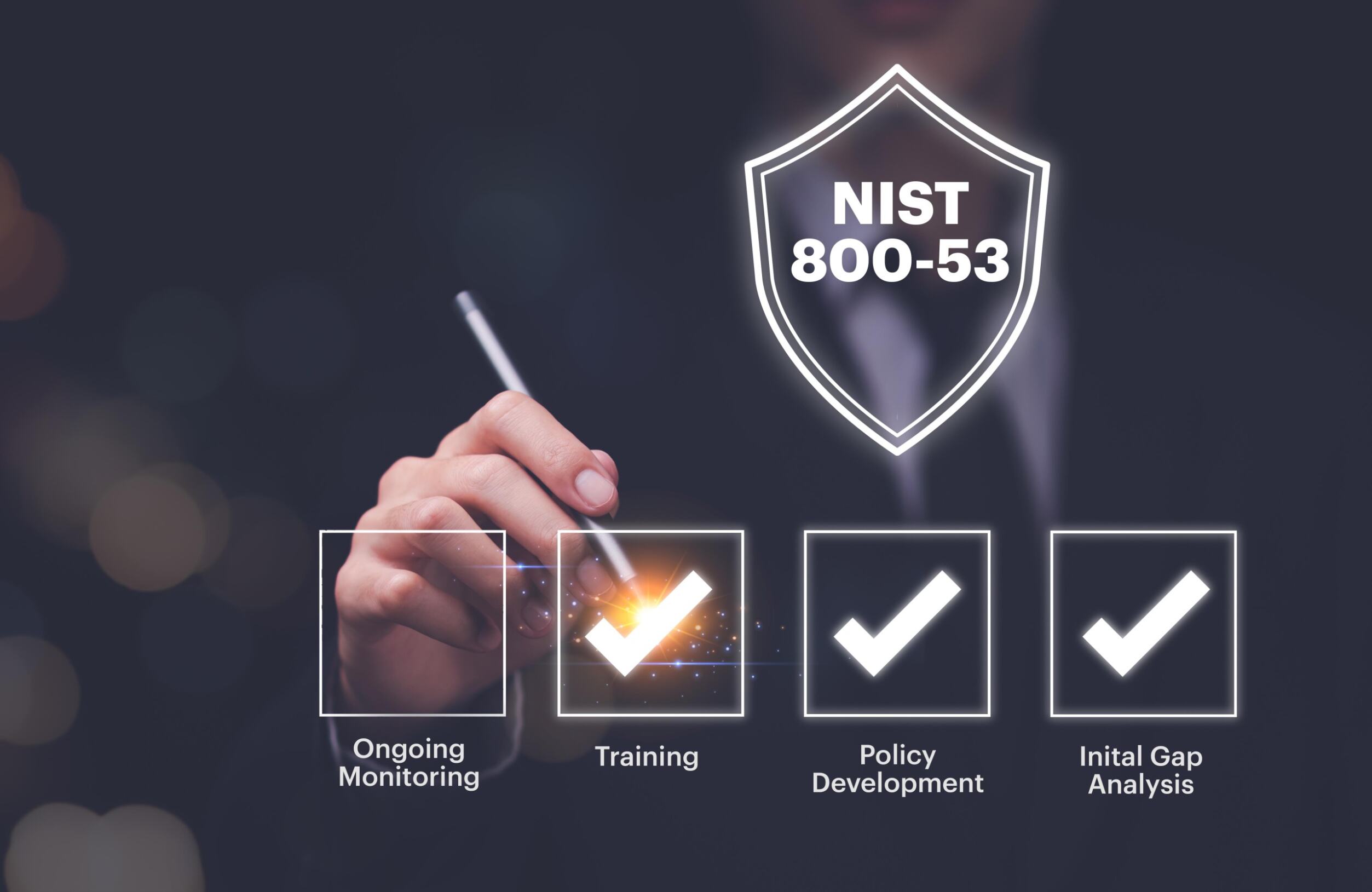Safeguarding sensitive information, proprietary data, and consumer records through robust cybersecurity measures is a large priority for organizations across both private and public sectors. Adhering to industry regulations and cybersecurity standards is critical for maintaining smooth operations, earning public trust, and minimizing financial risks.
The National Institute of Standards and Technology (NIST) is a leading authority in shaping cybersecurity standards and regulations to strengthen organizations’ infrastructure and security posture. Among its many contributions and resources, NIST Special Publication (SP) 800-53 is one of the most widely respected and comprehensive frameworks NIST maintains. Formally entitled “Security and Privacy Controls for Federal Information Systems and Organizations,” NIST SP 800-53 offers detailed and adaptable guidelines that promote cybersecurity excellence.
This guide provides valuable insights and actionable strategies to achieve and maintain NIST 800-53 compliance, covering everything from core principles to strategies for implementing robust security and privacy controls.
Understanding the Role of NIST 800-53
As cybersecurity is ever evolving, the risk of debilitating data breaches, ransomware attacks, and other cyber threats loom large, posing significant financial risks to businesses and organizations globally. Given the rising sophistication of cybercriminal techniques, organizations must protect their assets through robust cybersecurity frameworks.
The Origins of NIST 800-53
The NIST SP 800-53 framework plays an important role in shaping the United States’ cybersecurity and privacy standards. Initially mandated by the Federal Information Security Management Act (FISMA) of 2002 to protect federal information and systems, it was later updated in 2014. NIST published its first version of SP 800-53 in 2005 in response to the growing need for enhanced data security regulations in an expanding online landscape.
A Comprehensive and Evolving Framework for All
While compliance is mandatory for federal information systems, government agencies, and government contractors, NIST 800-53 is also a helpful framework for private-sector businesses. Adopting the minimum outlined controls within NIST 800-53 helps provide comprehensive coverage of the most common risk factors many organizations face.
With over 1,000 security and privacy controls, NIST 800-53 Revision 5 (Rev. 5) provides a structured yet flexible strategy to accommodate organizations’ specific cybersecurity needs and available resources. The framework’s security and privacy controls are divided across 20 unique control families. These families address various aspects of cybersecurity, including access control, awareness and training, and configuration management, incident response, risk assessment, supply chain risk management, and more. NIST 800-53’s distinct structure and organization help simplify the complexities of cybersecurity while supporting a shared understanding and common language around cyber risk.
How to Use NIST 800-53 with Other Frameworks
Organizations can leverage the guidance of multiple frameworks to establish more robust cybersecurity practices and ensure strict compliance with relevant regulatory requirements. NIST 800-53 complements other popular cybersecurity frameworks.
- ISO 27001 – NIST 800-53 and ISO 27001 are both comprehensive frameworks for establishing and maintaining an information security management system (ISMS). While ISO 27001 focuses on risk management and continuous improvement, it doesn’t meet all the security requirements a contractor needs in order to work with the federal government. NIST 800-53’s detailed security controls are tailored to federal information systems. Organizations can use ISO 27001 to establish their ISMS and then leverage NIST 800-53 controls to meet specific security requirements, particularly when pursuing government contracts.
- CIS Controls – The Center for Internet Security (CIS) Controls are a prioritized set of cybersecurity best practices designed to help organizations mitigate the most common cyber threats. While CIS Controls focus on practical and actionable security measures, NIST 800-53 controls are more comprehensive and detailed, covering a broader range of security domains and requirements. Organizations can use the CIS Controls as a baseline for implementing foundational security measures and then refer to NIST 800-53 for additional controls and guidance in complex or high-risk situations.
- GDPR – Within the European Union, the General Data Protection Regulation (GDPR) mandates strict requirements for protecting individuals’ privacy and personal data. International organizations subject to GDPR can use NIST 800-53 controls to help meet the regulation’s security requirements, particularly in areas such as access control, encryption, incident response, and data breach notifications.
The Value of NIST 800-53 Adoption
Embracing the NIST SP 800-53 framework is a strategic investment in any organization’s cybersecurity resilience and security posture. As businesses align with NIST 800-53’s controls, they reduce their cyber risk and create a company culture that prioritizes security awareness at every level.
A Business Owner’s Guide to NIST 800-53
NIST 800-53 provides a catalog of security and privacy controls to protect information systems and organizational assets from various risks. The controls are flexible and tailored to address diverse requirements, including industry regulations, legal mandates, executive orders, or other standards. Through its accessibility and adaptability, the NIST 800-53 framework empowers business owners and leaders to improve their security posture within their budgets.
For organizations lacking the time or personnel to implement NIST 800-53, cybersecurity consultants can help develop, prioritize, and improve security protocols to align with the organization’s objectives.
Using NIST 800-53A
NIST provides its own resources to help complement adopting NIST 800-53, including NIST SP 800-53A. An extension of the NIST 800-53 framework formally titled “Assessing Security and Privacy Controls in Information Systems and Organizations,” NIST SP 800-53A provides proper guidance on evaluating the effectiveness of organizations’ existing security and privacy controls.
A NIST 800-53 Implementation Roadmap
Organizations’ specific needs and resources vary. However, some of the most common steps for NIST 800-53 implementation include:
- Gap Analysis and Risk Assessments – A thorough gap analysis can reveal potential weaknesses in existing security measures. Regular risk assessments should be conducted to determine and rank risks based on their likelihood of occurring and potential impact. Focus risk management and disaster recovery planning efforts on security and privacy controls that address the most critical vulnerabilities first.
- Buy-in and Collaboration – Securing buy-in and commitments from senior leadership and management throughout the organization is critical. By collaborating interdepartmentally, the organization gains insight into the most critical measures to bring the most value.
- Policy Development and Documentation – Develop comprehensive cybersecurity policies and procedures that align with NIST SP 800-53 controls. Documenting clear and concise policies for all employees ensures consistency and easy access to the best security practices for their roles.
- Training and Awareness Programs – Implement cybersecurity training and awareness programs to educate all employees on their responsibilities. Regularly inform employees of new or revised security policies and procedures. Insider threats pose a significant risk to many organizations, whether malicious or unintentional. Security awareness and training sessions are among the most effective ways organizations can curb the risk of insider threats.
- Supply Chain and Vendor Risk Management – According to SecurityScorecard research, 98 percent of organizations have a relationship with at least one third party that has experienced a breach in the last two years.” Requiring third-party suppliers to comply with relevant NIST 800-53 controls can significantly mitigate risk.
- Ongoing Monitoring, Audits, and Review – Establish repeatable protocols for continuous monitoring of networks, systems, and processes to detect and respond to security incidents in real-time. Regular reviews and periodic audits of implemented controls ensure they remain relevant and effective.
The Most Impactful NIST 800-53 Controls
Cybersecurity professionals at MITRE ATT&CK review each of NIST SP 800-53’s security and privacy controls. Their assigned “impact scores” help indicate to peers and interested organizations which NIST 800-53 controls can make the biggest difference and hold greater significance for strengthening cybersecurity posture.
The NIST SP 800-53 control families that feature controls with the highest available MITRE ATT&CK impact scores include:
- Configuration Management (CM)
- Identification & Authentication (IA)
- System & Information Integrity (SI)
- Access Control (AC)
- Audit & Accountability (AU)
- System & Communication Protection (SC)
- Incident Response (IR)
LEARN MORE: Navigating NIST 800-53: A Deep Dive Into Compliance
In-House or On-Demand? A Dedicated CISO is Essential in NIST 800-53 Adoption
Small and mid-size businesses often overlook the value of a chief information security officer (CISO) in their organizational leadership. As cyber threats have evolved, so has the CISO role. A CISO’s specific responsibilities vary depending on the organization’s industry, assets, and unique challenges. However, a CISO generally specializes in cybersecurity with a focus on risk management, incident response, and control implementation.
The Benefits of On-Demand CISO Services
In some cases, hiring a full-time in-house CISO represents a costly financial burden. In others, having just one individual responsible for all cybersecurity measures without a suitable support staff could create an overwhelming and unsustainable situation.
By partnering with a CISO-on-demand provider, companies can rely on the industry knowledge and expertise of a CISO without the administrative burden associated with new hires. Even if an organization already has an in-house CISO, an on-demand “CISO as a service” can complement existing efforts or take on a new project, such as implementing NIST SP 800-53 controls.
An on-demand CISO as a service offers valuable support and expert guidance to help organizations cost-efficiently navigate the complexities of their cybersecurity journeys and achieve NIST 800-53 compliance.
A CISO’s Role in NIST 800-53 Compliance
CISOs have extensive experience and expertise in cybersecurity, especially with NIST frameworks and other industry best practices. In-house or on-demand, a CISO can provide guidance, curate strategies, and help organizations meet NIST 800-53 compliance in several significant ways:
- Gap Analyses and Risk Assessments – A CISO can lead an organization’s risk assessments to help prioritize future cybersecurity efforts in line with NIST 800-53 controls. By comparing the organization’s existing security posture against NIST 800-53 requirements, the CISO identifies cybersecurity vulnerabilities that need to be addressed.
- Implementation Planning – As security gaps are discovered, a CISO can develop a comprehensive implementation plan for effective NIST 800-53 security and privacy controls. During the planning, a CISO will engage business leaders across departments to help rank priorities and reallocate resources in line with organizational workflows.
- Crafting Custom-Tailored Cybersecurity Policies – After assessing the organization’s specific needs, risks, and security posture, a CISO can translate requirements into clear, tailored policies aligned with the organization’s objectives. These policies should provide a high-level overview of business leaders’ commitment to cybersecurity, setting the tone for company culture.
- Developing Detailed Procedures – A CISO is highly involved in developing detailed procedures that outline the precise actions necessary to implement effective cybersecurity controls. Procedures are much more technical and granular than overarching policies, providing clear instructions for employees to follow while ensuring policies are effective and consistent. For example, a CISO’s cybersecurity procedures may detail the process for responding to a cybersecurity incident, including initial actions, reporting protocols, and steps for post-incident analysis.
- Establishing a Culture of Compliance and Awareness – A CISO can play a crucial role in embedding NIST 800-53 controls and effective cybersecurity policies and procedures into an organization’s culture. Creating a culture of awareness around security may involve training modules, education opportunities, and regular communications that warn of new threats. It should also highlight the importance of cybersecurity and reiterate each employee’s role in maintaining a security posture. CISOs can ensure that cyber policies and procedures are integrated into the daily operations and organization mindset.
- Continuous Monitoring – CISOs establish processes for continuous monitoring to ensure ongoing compliance with NIST 800-53 controls and other cybersecurity regulations. From reviewing security logs and analyzing security incidents to conducting vulnerability scans and ongoing assessments, a CISO can adapt or make necessary adjustments to cybersecurity controls or policies.
LEARN MORE: What is a CISO and Why Does Your Business Need One?
Maintaining NIST 800-53 Compliance with Updates and Revisions in an Ever-Shifting Cyber Landscape
NIST’s revision process is an ongoing collaborative effort involving continuous review, improvement, and refinement of the framework. NIST monitors the global cybersecurity landscape closely for emerging threats, exploitable vulnerabilities, and relevant technological advancements.
Key steps in the NIST 800-53 revision and update process include:
- Stakeholder Engagement and Feedback – NIST solicits valuable feedback from federal agencies, industry experts, academic institutions, members of the public, and other cybersecurity stakeholders. With an open and inclusive approach, NIST ensures its revisions consider diverse perspectives and real-world applications.
- Collaborative Groups – NIST often forms collaborative groups of experts across various sectors to explore specific cybersecurity issues, emerging technologies, and potential implications. The insights gained from experienced industry experts play a significant role in drafting proposed changes or additions to NIST SP 800-53’s security and privacy controls.
- Public Review and Comment – NIST releases draft versions of its SP 800-53 updates for public review and comments. This approach ensures the final version of the publication is practical and comprehensive for as many users as possible. \
Streamlining NIST 800-53 with Rev. 5
NIST released its latest version of SP 800-53, Rev. 5, in late 2020. The organization refers to Rev. 5 as “not just a minor update but rather a complete renovation—addressing both structural issues and technical content.”
NIST 800-53 Rev. 5 reflects a multi-year endeavor to revamp security and privacy controls across various sectors and system types. Some of the key changes in Rev. 5 include:
- Outcome-Based Controls – Rev. 4 referred to common roles within government agencies. However, government contractors, private companies fulfilling government contracts, or non-government organizations seeking compliance don’t have those roles. By rewording the control statements in Rev. 5, the focus shifted from the government agency role responsible to the desired goals of specific actions.
- Consolidated Control Catalog – Rev. 5 integrates security and privacy controls into a consolidated catalog, enhancing efficiency and facilitating control implementation. For example, some privacy controls from Revision 4 are now assigned to a dedicated privacy control family and the existing Program Management family.
- Supply Chain Risk Management (SCRM) – Rev. 5 introduces a new control family, Supply Chain Risk Management (SCRM). This control family streamlines supply chain controls, enhances supplier assessment and review processes, and fosters more efficient supply chain management. Integrating a plan for supply chain risk management throughout other control families helps protect components, products, and services within critical systems and infrastructures.
- Control Baselines and Tailoring Guidance – A separate publication, NIST SP 800-53B, houses control baselines catering to federal agencies’ specific requirements. Organizations can also develop customized baselines aligned with their mission and risk tolerance.
- Improved Content Relationships – Rev. 5 clarifies the relationships between requirements, measures, and security and privacy controls. This clarity enhances understanding and implementation at the enterprise level or within a system engineering process.
- State-of-the-Practice Controls – New controls in Rev. 5 are based on the latest threat intelligence and cyberattack data, addressing evolving cyber threats while safeguarding critical assets and personally identifiable information.
NIST 800-53 is a cornerstone framework for organizations striving to strengthen their cybersecurity posture and achieve compliance with federal standards. To remain compliant with NIST 800-53, organizations must use Rev. 5. Because Rev. 4 controls are over a decade old, even non-federal agencies and non-government contractors should implement Rev 5.





